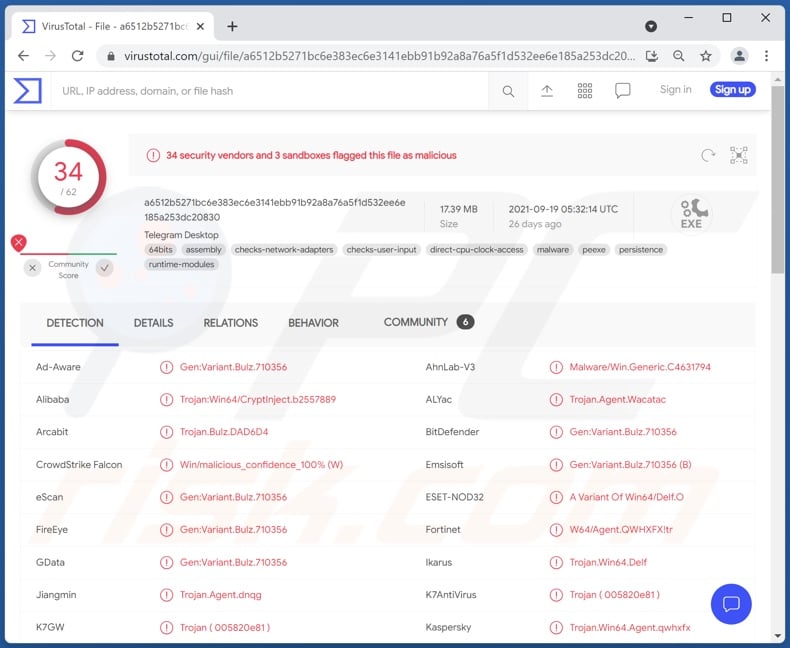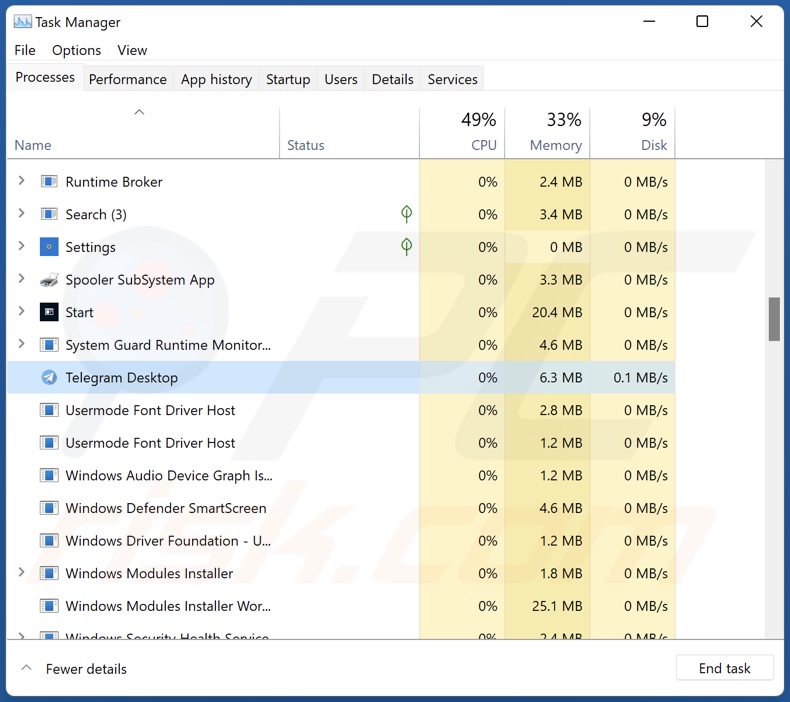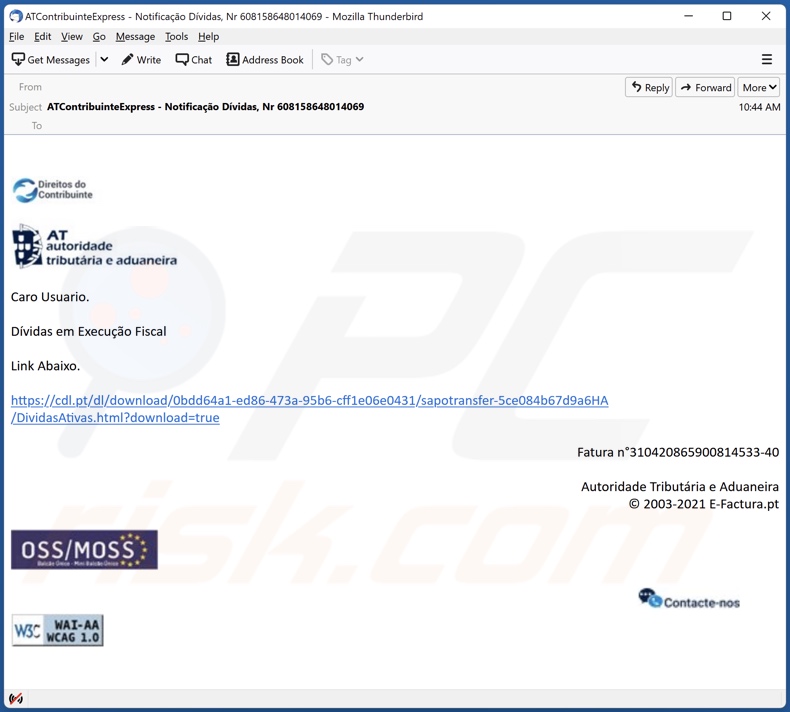How to eliminate the Maxtrilha trojan from your operating system?
TrojanAlso Known As: Maxtrilha malware
Get free scan and check if your device is infected.
Remove it nowTo use full-featured product, you have to purchase a license for Combo Cleaner. Seven days free trial available. Combo Cleaner is owned and operated by RCS LT, the parent company of PCRisk.com.
What is Maxtrilha?
Maxtrilha is the name of a banking trojan. This piece of malicious software is designed to target victims' banking accounts and their log-in credentials. Maxtrilha has been especially active in Latin America and certain countries in Europe (notably Portugal). This malware has been observed being spread through phishing spam campaigns.

Maxtrilha malware overview
After Maxtrilha has successfully infected a system and ensured its persistence, it begins displaying overlay windows on banking websites. These fake pages mimic the visited online bank and record victims' log-in credentials (i.e., IDs, email addresses, usernames, and passwords), which they enter thinking that the sign-in webpage is legitimate.
By obtaining this information, cyber criminals can gain access and control over compromised banking accounts. Therefore, they may be able to make fraudulent transactions and/or online purchases.
Furthermore, Maxtrilha can receive and execute other commands. This trojan also has loader/backdoor capabilities, meaning that it can infect systems with additional malware.
Hence, this malicious program could inject devices with others that have extensive data-stealing abilities, e.g., keylogging (key-stroke recording), file exfiltration from the system, information extraction from browsers and various installed applications, taking screenshots, recording/live-streaming audio and video via microphones and cameras, etc.
Another popular malware-type is ransomware, which is designed to encrypt data and/or lock the device's screen in order to make ransom demands for the decryption/ access recovery. Cryptominers are a type of malware that abuse system resources to generate cryptocurrency.
To summarize, Maxtrilha can cause multiple system infections, severe privacy issues, significant financial losses, and lead to identity theft. Therefore, it is crucial to remove all threats with the aid of anti-virus software.
| Name | Maxtrilha malware |
| Threat Type | Trojan, password-stealing virus, banking malware, spyware. |
| Detection Names | Avast (Win64:MalwareX-gen [Trj]), Combo Cleaner (Gen:Variant.Bulz.710356), ESET-NOD32 (A Variant Of Win64/Delf.O), Kaspersky (Trojan.Win64.Agent.qwhxfx), Microsoft (Trojan:Win32/CryptInject!MSR), Full List Of Detections (VirusTotal) |
| Malicious Process Name(s) | Telegram Desktop (process name may vary) |
| Symptoms | Trojans are designed to stealthily infiltrate the victim's computer and remain silent, and thus no particular symptoms are clearly visible on an infected machine. |
| Distribution methods | Infected email attachments, malicious online advertisements, social engineering, software 'cracks'. |
| Damage | Stolen passwords and banking information, identity theft, the victim's computer added to a botnet. |
| Malware Removal (Windows) |
To eliminate possible malware infections, scan your computer with legitimate antivirus software. Our security researchers recommend using Combo Cleaner. Download Combo CleanerTo use full-featured product, you have to purchase a license for Combo Cleaner. 7 days free trial available. Combo Cleaner is owned and operated by RCS LT, the parent company of PCRisk.com. |
Banking trojan examples
Numando, Lampion, and Mekotio are a few examples of banking malware. However, it is common for malicious programs to have various harmful abilities in different combinations. Hence, the threats posed by malware can be particularly broad. Regardless of how malicious software operates, it endangers device/user safety and must be eliminated immediately upon detection.
How did Maxtrilha infiltrate my computer?
Maxtrilha has been noted being actively proliferated via phishing spam campaigns. The emails that spread this trojan tend to be skillfully disguised as genuine notifications from online banks and other legitimate entities.
Spam emails cause infections through the virulent files attached to and/or linked inside them. These files can be Microsoft Office and PDF documents, archives, executables, JavaScript, etc. When they are opened - the infection process is triggered.
Malware is also distributed through dubious download channels, e.g., unofficial and free file-hosting sites, Peer-to-Peer sharing networks, etc. Illegal activation ("cracking") tools and fake updates are used in distribution as well. "Cracks" can infect systems rather than activate licensed software. Fake updaters cause infections by exploiting outdated programs and/or by installing malicious software.
How to avoid installation of malware?
It is advised against opening suspicious/irrelevant emails - especially their attachments and links that are origins of potential infections. It is recommended to only download from official and verified sources. Furthermore, all programs must be activated and updated with tools provided by legitimate developers.
It is crucial to have a reputable anti-virus installed and kept updated. This software has to be used to run regular system scans. If you believe that your computer is already infected, we recommend running a scan with Combo Cleaner Antivirus for Windows to automatically eliminate infiltrated malware.
Screenshot of Maxtrilha trojan's process on Windows Task Manager ("Telegram Desktop" process name):

Screenshot of a spam email used to spread Maxtrilha trojan:

Text presented in this email letter:
Subject: ATContribuinteExpress - Notificação Dívidas, Nr 608158648014069
Direitos do
Contribuinte
AT
autoridade
tributária e aduaneira
Caro Usuario.
Dívidas em Execução Fiscal
Link Abaixo.
-
Fatura n°310420865900814533-40
Autoridade Tributária e Aduaneira
© 2003-2021 E-Factura.pt
Instant automatic malware removal:
Manual threat removal might be a lengthy and complicated process that requires advanced IT skills. Combo Cleaner is a professional automatic malware removal tool that is recommended to get rid of malware. Download it by clicking the button below:
DOWNLOAD Combo CleanerBy downloading any software listed on this website you agree to our Privacy Policy and Terms of Use. To use full-featured product, you have to purchase a license for Combo Cleaner. 7 days free trial available. Combo Cleaner is owned and operated by RCS LT, the parent company of PCRisk.com.
Quick menu:
- What is Maxtrilha?
- STEP 1. Manual removal of Maxtrilha malware.
- STEP 2. Check if your computer is clean.
How to remove malware manually?
Manual malware removal is a complicated task - usually it is best to allow antivirus or anti-malware programs to do this automatically. To remove this malware we recommend using Combo Cleaner Antivirus for Windows.
If you wish to remove malware manually, the first step is to identify the name of the malware that you are trying to remove. Here is an example of a suspicious program running on a user's computer:

If you checked the list of programs running on your computer, for example, using task manager, and identified a program that looks suspicious, you should continue with these steps:
 Download a program called Autoruns. This program shows auto-start applications, Registry, and file system locations:
Download a program called Autoruns. This program shows auto-start applications, Registry, and file system locations:

 Restart your computer into Safe Mode:
Restart your computer into Safe Mode:
Windows XP and Windows 7 users: Start your computer in Safe Mode. Click Start, click Shut Down, click Restart, click OK. During your computer start process, press the F8 key on your keyboard multiple times until you see the Windows Advanced Option menu, and then select Safe Mode with Networking from the list.

Video showing how to start Windows 7 in "Safe Mode with Networking":
Windows 8 users: Start Windows 8 is Safe Mode with Networking - Go to Windows 8 Start Screen, type Advanced, in the search results select Settings. Click Advanced startup options, in the opened "General PC Settings" window, select Advanced startup.
Click the "Restart now" button. Your computer will now restart into the "Advanced Startup options menu". Click the "Troubleshoot" button, and then click the "Advanced options" button. In the advanced option screen, click "Startup settings".
Click the "Restart" button. Your PC will restart into the Startup Settings screen. Press F5 to boot in Safe Mode with Networking.

Video showing how to start Windows 8 in "Safe Mode with Networking":
Windows 10 users: Click the Windows logo and select the Power icon. In the opened menu click "Restart" while holding "Shift" button on your keyboard. In the "choose an option" window click on the "Troubleshoot", next select "Advanced options".
In the advanced options menu select "Startup Settings" and click on the "Restart" button. In the following window you should click the "F5" button on your keyboard. This will restart your operating system in safe mode with networking.

Video showing how to start Windows 10 in "Safe Mode with Networking":
 Extract the downloaded archive and run the Autoruns.exe file.
Extract the downloaded archive and run the Autoruns.exe file.

 In the Autoruns application, click "Options" at the top and uncheck "Hide Empty Locations" and "Hide Windows Entries" options. After this procedure, click the "Refresh" icon.
In the Autoruns application, click "Options" at the top and uncheck "Hide Empty Locations" and "Hide Windows Entries" options. After this procedure, click the "Refresh" icon.

 Check the list provided by the Autoruns application and locate the malware file that you want to eliminate.
Check the list provided by the Autoruns application and locate the malware file that you want to eliminate.
You should write down its full path and name. Note that some malware hides process names under legitimate Windows process names. At this stage, it is very important to avoid removing system files. After you locate the suspicious program you wish to remove, right click your mouse over its name and choose "Delete".

After removing the malware through the Autoruns application (this ensures that the malware will not run automatically on the next system startup), you should search for the malware name on your computer. Be sure to enable hidden files and folders before proceeding. If you find the filename of the malware, be sure to remove it.

Reboot your computer in normal mode. Following these steps should remove any malware from your computer. Note that manual threat removal requires advanced computer skills. If you do not have these skills, leave malware removal to antivirus and anti-malware programs.
These steps might not work with advanced malware infections. As always it is best to prevent infection than try to remove malware later. To keep your computer safe, install the latest operating system updates and use antivirus software. To be sure your computer is free of malware infections, we recommend scanning it with Combo Cleaner Antivirus for Windows.
Frequently Asked Questions (FAQ)
My computer is infected with Maxtrilha malware, should I format my storage device to get rid of it?
Maxtrilha malware can be removed without formatting.
What are the biggest issues that Maxtrilha malware can cause?
The threats posed by a malicious program depend on its abilities and the cyber criminals' modus operandi. As a banking trojan, Maxtrilha targets online bank accounts and finance-related information - this makes it a threat to victims' financial integrity. However, Maxtrilha can also infect systems with additional malware; hence, the dangers posed by this trojan are extensive. In general, malicious software infections can result in diminished system performance, system failure, hardware damage, permanent data loss, severe privacy issues, financial losses, identity theft, etc.
What is the purpose of Maxtrilha malware?
Maxtrilha banking trojan is designed to generate revenue for the cyber criminals. This is the most common aim of malware, yet other goals are possible. For example, malicious programs can be released for the criminals' amusement, targeting specific persons (personal reasons), political or geopolitical motivations, disrupting certain websites/services/companies, etc.
How did Maxtrilha malware infiltrate my computer?
Maxtrilha has been notably spread through email spam campaigns. Other popular malware proliferation techniques include: drive-by downloads, dubious download channels (e.g., unofficial, freeware, and scam sites; Peer-to-Peer sharing networks, etc.), illegal software activation tools ("cracks"), fake updates, and so on. Some malicious programs are capable of self-proliferating via local networks and removable storage devices (e.g., external hard drives, USB flash drives, etc.).
Will Combo Cleaner protect me from malware?
Yes, Combo Cleaner can detect and eliminate almost all known malware infections. It is noteworthy that high-end malicious software typically hides deep in the system. Therefore, running a full system scan is crucial.
Share:

Tomas Meskauskas
Expert security researcher, professional malware analyst
I am passionate about computer security and technology. I have an experience of over 10 years working in various companies related to computer technical issue solving and Internet security. I have been working as an author and editor for pcrisk.com since 2010. Follow me on Twitter and LinkedIn to stay informed about the latest online security threats.
PCrisk security portal is brought by a company RCS LT.
Joined forces of security researchers help educate computer users about the latest online security threats. More information about the company RCS LT.
Our malware removal guides are free. However, if you want to support us you can send us a donation.
DonatePCrisk security portal is brought by a company RCS LT.
Joined forces of security researchers help educate computer users about the latest online security threats. More information about the company RCS LT.
Our malware removal guides are free. However, if you want to support us you can send us a donation.
Donate
▼ Show Discussion